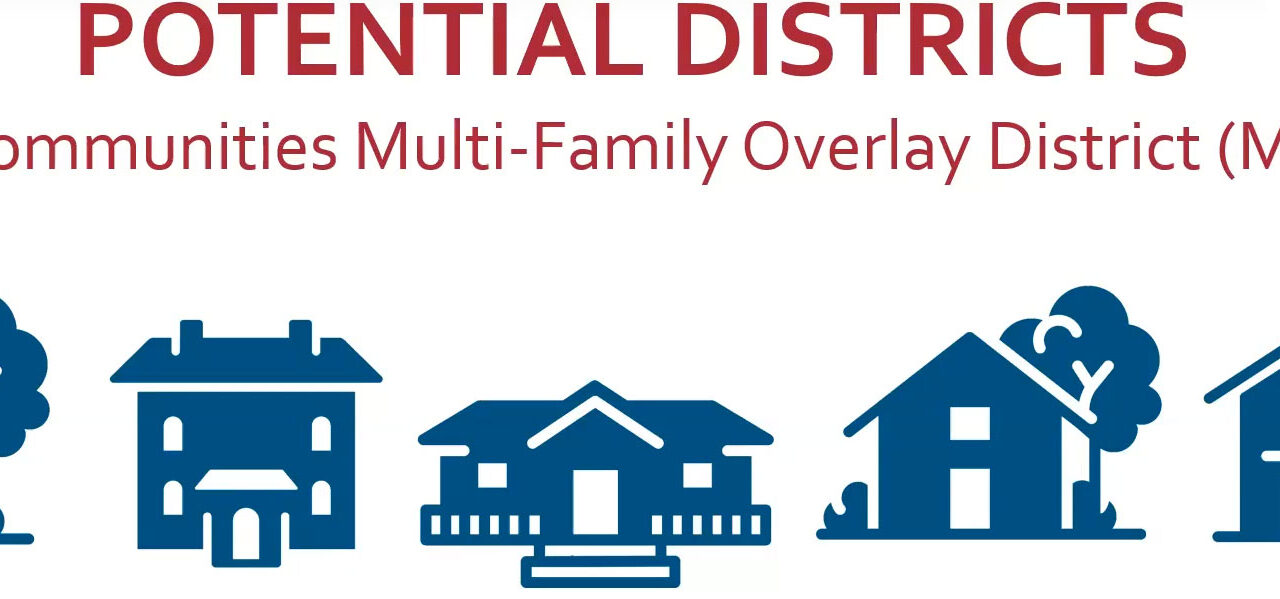By MARK SARDELLA
WAKEFIELD — The Town Council’s 40A Subcommittee held its second public forum last week to discuss their plan to comply with the state mandate that would force communities with MBTA service to create at least one zone near public transit where multifamily housing is allowed as of right.
Passed by the legislature in 2021, Section 3A of Massachusetts General Laws Chapter 40A requires all MBTA communities to have at least one zoning district of reasonable size near a transit station in which multifamily housing is permitted by right.
Last spring, Annual Town Meeting rejected three different compliance models. One of those was created by a Working Group of the Planning Board and went well beyond the state mandate in terms of geographic area and potential new housing units. Two minimum compliance plans were also rejected by voters.
The Town Council subsequently decided that it would take a crack at developing a compliance model that might be acceptable to voters at the November Town Meeting. The town has until Dec. 31, 2024 to comply with the mandate. The state has threatened non-compliant communities with loss of grant monies and the Attorney General has threatened lawsuits against towns that don’t comply.
At the start of last Thursday’s public forum, Town Councilor Robert Vincent, who sits on the 40A Subcommittee, attempted to explain why another plan was being put forth even after voters rejected three previous compliance models.
He noted that all three members of the 40A Subcommittee are lawyers, as is Town Administrator Stephen P. Maio. The four attorneys, he said, shared the opinion that it was important to let Town Meeting decide on compliance, not the seven-member Town Council. In order to afford voters that opportunity, the Town Council had to offer voters one more plan before the deadline.
Maio reminded those in attendance at the forum that in November of 2015, years before the current mandate, Town Meeting voters approved a local zoning change designed to encourage mixed-use development in the downtown business districts and along public transit lines.

“We passed a bylaw and a lot got built,” he noted. But the new state mandate under Chapter 40A won’t allow Wakefield to take credit for those housing units in its compliance plan.
So, the latest plan overlays the compliance district over some of those already developed areas, like North Avenue and Foundry Street. Under the law, there is potential for many more units to be built in those districts. However, town officials believe those units are unlikely to be built since the areas are already developed. The net result is that the town gets credit for the potential units, but the actual effect on the character of the neighborhoods is minimal.
Senior Town Planner Samantha Elliott discussed the areas identified by the subcommittee for inclusion in a compliance map. They include North Avenue, Foundry Street, Albion Street, Audubon Road and areas of Greenwood near the train station.
Elliott explained that Wakefield’s plan needs to have a minimum of 36 acres and 1,696 potential units. Seventy-five percent of the district must be near a train station. Up to 25 percent can be away from transit, which is why an already developed area of Audubon Road was included.
The intention of the proposed plan is that the character of each of the areas identified would remain effectively unchanged.
Asked by a resident about the amount of state grant money that the town would stand to lose if it refused to comply with the mandate, Chairman Michael McLane indicated that it came out to an average of roughly $700,000 annually based on the last five years.
The resident predicted that it would cost the town far more than that for more teachers and other costs related to adding more housing.
Marcy McCauley of Walden Road brought up the tax impact of the new high school, which most residents have not even felt yet.
Maio suggested that adding more housing would spread that tax burden over more homes.
Scot McCauley of Walden Road asked if the town had done a financial study to determine the potential cost of compliance for infrastructure, schools, etc. He also noted that a recent survey done by the town did not show overwhelming support for compliance.
He also predicted that the result of compliance will be single-family homes getting “scooped up” by developers.
Town Councilor John Carney observed that the subcommittee’s plan removed a lot of the risk from compliance, but it should be up to Town Meeting to decide.
The 40A compliance plan is expected to be on the warrant for the Nov. 16 Regular Town Meeting.





